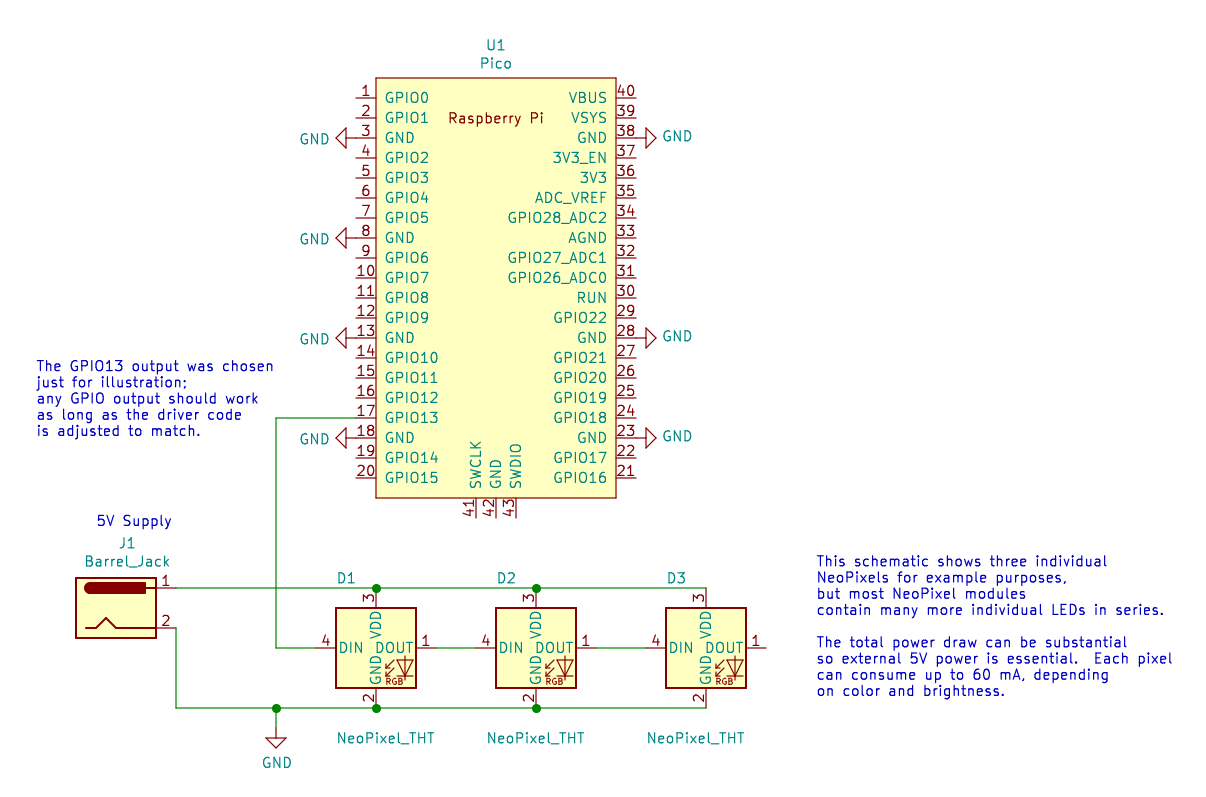NeoPixel LED Examples - Raspberry Pi Pico¶
The following short Python programs will demonstrate essential operation of the
Raspberry Pi Pico board. These assume one or more binary input or output circuits are
externally attached. Each can be run by copying the program into code.py on
the CIRCUITPY drive offered by the board. The text can be pasted directly from
this page, or each file can be downloaded from the CircuitPython sample code
folder on this site.
Related Pages
Sample NeoPixel Circuit¶

Sample NeoPixel circuit. Any GPIO pins may be used to send data to the LEDs. Please note that an LED array of even modest size will generally need a separate 5V power supply.¶
Neopixel Demo¶
Direct download: neopixel_demo.py.
1 2 3 4 5 6 7 8 9 10 11 12 13 14 15 16 17 18 19 20 21 22 23 24 25 26 27 28 29 30 31 32 33 34 35 36 37 38 39 40 41 42 43 44 45 46 47 48 49 50 51 52 53 54 55 56 57 58 59 60 61 62 63 64 65 66 67 68 69 70 71 72 | # neopixel_demo.py
# Raspberry Pi Pico - NeoPixel LED array demo
# Write an animated pattern to a strand of NeoPixel LEDS, using only the
# low-level neopixel_write module.
################################################################
# CircuitPython module documentation:
# time https://circuitpython.readthedocs.io/en/latest/shared-bindings/time/index.html
# board https://circuitpython.readthedocs.io/en/latest/shared-bindings/board/index.html
# digitalio https://circuitpython.readthedocs.io/en/latest/shared-bindings/digitalio/index.html
# neopixel_write https://circuitpython.readthedocs.io/en/latest/shared-bindings/neopixel_write/index.html
#
################################################################################
# load standard Python modules
import time
# load the CircuitPython hardware definition module for pin definitions
import board
# load the CircuitPython GPIO support
import digitalio
# load the CircuitPython NeoPixel output support
import neopixel_write
#---------------------------------------------------------------
# The NeoPixel strand uses one GPIO output. Note that in general it will need
# separate 5V power, only the smallest arrays can use USB power.
pixels = digitalio.DigitalInOut(board.GP13)
pixels.direction = digitalio.Direction.OUTPUT
# The number of NeoPixels must be specified, as they cannot be detected. This
# demo can support hundreds of NeoPixels: at 200 pixels, the frame rate is still
# 30 Hz, at 400 pixels that drops to 17 Hz. This could be improved: the data
# rate is 800 kHz, so with a 30Hz frame rate the strand can theoretically be
# 1100 pixels.
num_pixels = 12
# Create a buffer for storing a complete linear image. The color order and
# depth depends upon the specific devices, but are typically 3 bytes (24 bits)
# per pixel in BGR order. The first pixel data will apply to the first device
# in the chain, the second to the next, etc. Excess data will have no effect.
# If less than a full frame is sent, the last pixels will not change.
frame_buffer = bytearray(3*num_pixels)
#---------------------------------------------------------------
# Run the main loop to generate a sequence of frames as fast as possible.
while True:
# generate the next frame based on the real-time clock value
now = time.monotonic_ns() / 1000
# generate a temporal color sequence with each component out of phase
red = int((now//11000) % 256)
grn = int((now//33000) % 256)
blu = int((now//55000) % 256)
# print(f"{red}, {grn}, {blu}")
# update the entire frame buffer including an additional position-dependent term
# to create spatial variation
for p in range(num_pixels):
frame_buffer[3*p] = (grn + 12*p) % 256
frame_buffer[3*p+1] = (red + 12*p) % 256
frame_buffer[3*p+2] = (blu + 12*p) % 256
# transfer the new frame to the NeoPixel LED strand
neopixel_write.neopixel_write(pixels, frame_buffer)
|